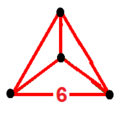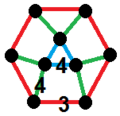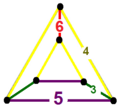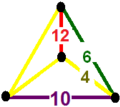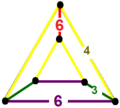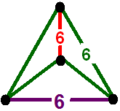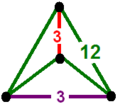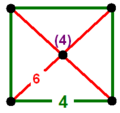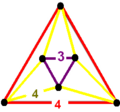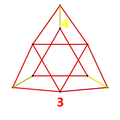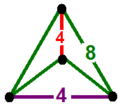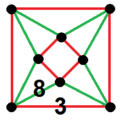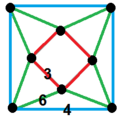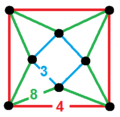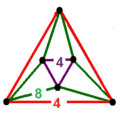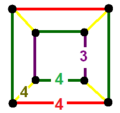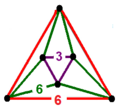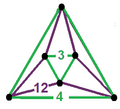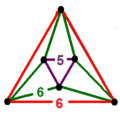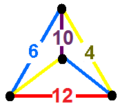Regular paracompact honeycombs
Of the uniform paracompact H3 honeycombs, 11 are regular , meaning that their group of symmetries acts transitively on their flags. These have Schläfli symbol {3,3,6}, {6,3,3}, {3,4,4}, {4,4,3}, {3,6,3}, {4,3,6}, {6,3,4}, {4,4,4}, {5,3,6}, {6,3,5}, and {6,3,6}, and are shown below. Four have finite Ideal polyhedral cells: {3,3,6}, {4,3,6}, {3,4,4}, and {5,3,6}.
| 11 paracompact regular honeycombs |
|---|

{6,3,3} | 
{6,3,4} | 
{6,3,5} | 
{6,3,6} | 
{4,4,3} | 
{4,4,4} |

{3,3,6} | 
{4,3,6} | 
{5,3,6} | 
{3,6,3} | 
{3,4,4} |
| Name | Schläfli
Symbol
{p,q,r} | Coxeter
       | Cell
type
{p,q} | Face
type
{p} | Edge
figure
{r} | Vertex
figure
{q,r} | Dual | Coxeter
group |
|---|
| Order-6 tetrahedral honeycomb | {3,3,6} |        | {3,3} | {3} | {6} | {3,6} | {6,3,3} | [6,3,3] |
| Hexagonal tiling honeycomb | {6,3,3} |        | {6,3} | {6} | {3} | {3,3} | {3,3,6} |
| Order-4 octahedral honeycomb | {3,4,4} |        | {3,4} | {3} | {4} | {4,4} | {4,4,3} | [4,4,3] |
| Square tiling honeycomb | {4,4,3} |        | {4,4} | {4} | {3} | {4,3} | {3,4,4} |
| Triangular tiling honeycomb | {3,6,3} |        | {3,6} | {3} | {3} | {6,3} | Self-dual | [3,6,3] |
| Order-6 cubic honeycomb | {4,3,6} |        | {4,3} | {4} | {4} | {3,6} | {6,3,4} | [6,3,4] |
| Order-4 hexagonal tiling honeycomb | {6,3,4} |        | {6,3} | {6} | {4} | {3,4} | {4,3,6} |
| Order-4 square tiling honeycomb | {4,4,4} |        | {4,4} | {4} | {4} | {4,4} | Self-dual | [4,4,4] |
| Order-6 dodecahedral honeycomb | {5,3,6} |        | {5,3} | {5} | {5} | {3,6} | {6,3,5} | [6,3,5] |
| Order-5 hexagonal tiling honeycomb | {6,3,5} |        | {6,3} | {6} | {5} | {3,5} | {5,3,6} |
| Order-6 hexagonal tiling honeycomb | {6,3,6} |        | {6,3} | {6} | {6} | {3,6} | Self-dual | [6,3,6] |
 | 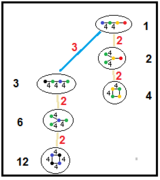 |
| These graphs show subgroup relations of paracompact hyperbolic Coxeter groups. Order 2 subgroups represent bisecting a Goursat tetrahedron with a plane of mirror symmetry. |
This is a complete enumeration of the 151 unique Wythoffian paracompact uniform honeycombs generated from tetrahedral fundamental domains (rank 4 paracompact coxeter groups). The honeycombs are indexed here for cross-referencing duplicate forms, with brackets around the nonprimary constructions.
The alternations are listed, but are either repeats or don't generate uniform solutions. Single-hole alternations represent a mirror removal operation. If an end-node is removed, another simplex (tetrahedral) family is generated. If a hole has two branches, a Vinberg polytope is generated, although only Vinberg polytope with mirror symmetry are related to the simplex groups, and their uniform honeycombs have not been systematically explored. These nonsimplectic (pyramidal) Coxeter groups are not enumerated on this page, except as special cases of half groups of the tetrahedral ones. Seven uniform honeycombs that arise here as alternations have been numbered 152 to 158, after the 151 Wythoffian forms not requiring alternation for their construction.
Tetrahedral hyperbolic paracompact group summary| Coxeter group | Simplex
volume | Commutator subgroup | Unique honeycomb count |
|---|
| [6,3,3] |        | 0.0422892336 | [1+,6,(3,3)+] = [3,3[3]]+ | 15 |
| [4,4,3] |        | 0.0763304662 | [1+,4,1+,4,3+] | 15 |
| [3,3[3]] |      | 0.0845784672 | [3,3[3]]+ | 4 |
| [6,3,4] |        | 0.1057230840 | [1+,6,3+,4,1+] = [3[]x[]]+ | 15 |
| [3,41,1] |      | 0.1526609324 | [3+,41+,1+] | 4 |
| [3,6,3] |        | 0.1691569344 | [3+,6,3+] | 8 |
| [6,3,5] |        | 0.1715016613 | [1+,6,(3,5)+] = [5,3[3]]+ | 15 |
| [6,31,1] |      | 0.2114461680 | [1+,6,(31,1)+] = [3[]x[]]+ | 4 |
| [4,3[3]] |      | 0.2114461680 | [1+,4,3[3]]+ = [3[]x[]]+ | 4 |
| [4,4,4] |        | 0.2289913985 | [4+,4+,4+]+ | 6 |
| [6,3,6] |        | 0.2537354016 | [1+,6,3+,6,1+] = [3[3,3]]+ | 8 |
| [(4,4,3,3)] |      | 0.3053218647 | [(4,1+,4,(3,3)+)] | 4 |
| [5,3[3]] |      | 0.3430033226 | [5,3[3]]+ | 4 |
| [(6,3,3,3)] |      | 0.3641071004 | [(6,3,3,3)]+ | 9 |
| [3[]x[]] |      | 0.4228923360 | [3[]x[]]+ | 1 |
| [41,1,1] |      | 0.4579827971 | [1+,41+,1+,1+] | 0 |
| [6,3[3]] |      | 0.5074708032 | [1+,6,3[3]] = [3[3,3]]+ | 2 |
| [(6,3,4,3)] |      | 0.5258402692 | [(6,3+,4,3+)] | 9 |
| [(4,4,4,3)] |     | 0.5562821156 | [(4,1+,4,1+,4,3+)] | 9 |
| [(6,3,5,3)] |      | 0.6729858045 | [(6,3,5,3)]+ | 9 |
| [(6,3,6,3)] |      | 0.8457846720 | [(6,3+,6,3+)] | 5 |
| [(4,4,4,4)] |      | 0.9159655942 | [(4+,4+,4+,4+)] | 1 |
| [3[3,3]] |    | 1.014916064 | [3[3,3]]+ | 0 |
The complete list of nonsimplectic (non-tetrahedral) paracompact Coxeter groups was published by P. Tumarkin in 2003. [1] The smallest paracompact form in H3 can be represented by 







 or
or 



 , or [∞,3,3,∞] which can be constructed by a mirror removal of paracompact hyperbolic group [3,4,4] as [3,4,1+,4] :
, or [∞,3,3,∞] which can be constructed by a mirror removal of paracompact hyperbolic group [3,4,4] as [3,4,1+,4] : 





 =
= 



 . The doubled fundamental domain changes from a tetrahedron into a quadrilateral pyramid. Another pyramid is
. The doubled fundamental domain changes from a tetrahedron into a quadrilateral pyramid. Another pyramid is 







 or
or 



 , constructed as [4,4,1+,4] = [∞,4,4,∞] :
, constructed as [4,4,1+,4] = [∞,4,4,∞] : 





 =
= 



 .
.
Removing a mirror from some of the cyclic hyperbolic Coxeter graphs become bow-tie graphs: [(3,3,4,1+,4)] = [((3,∞,3)),((3,∞,3))] or 



 , [(3,4,4,1+,4)] = [((4,∞,3)),((3,∞,4))] or
, [(3,4,4,1+,4)] = [((4,∞,3)),((3,∞,4))] or 



 , [(4,4,4,1+,4)] = [((4,∞,4)),((4,∞,4))] or
, [(4,4,4,1+,4)] = [((4,∞,4)),((4,∞,4))] or 



 .
. 




 =
= 





 ,
, 




 =
= 





 ,
, 




 =
= 





 .
.
Another nonsimplectic half groups is 



 ↔
↔ 





 .
.
A radical nonsimplectic subgroup is 



 ↔
↔ 





 , which can be doubled into a triangular prism domain as
, which can be doubled into a triangular prism domain as 





 ↔
↔ 




 .
.













